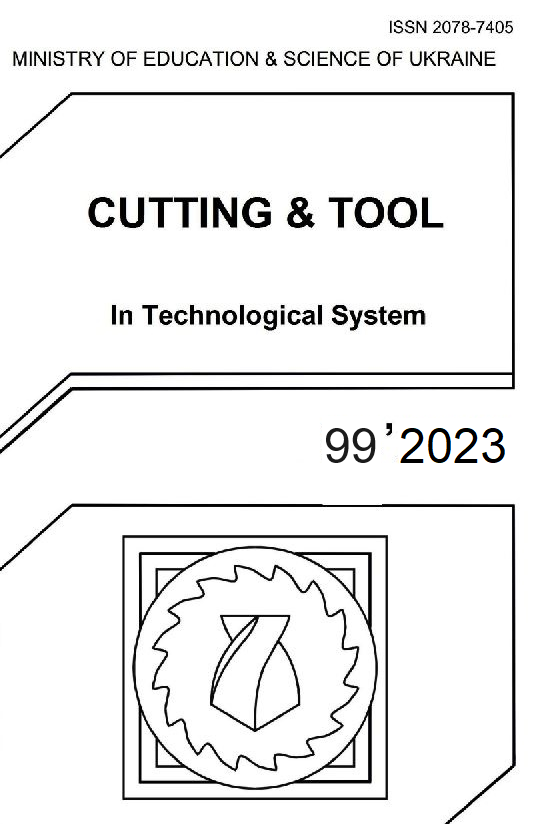PROBABILISTIC APPROACH TO CALCULATING THE RATIONAL THICKNESS OF THE TOOL`S CUTTING INSERT FOR HEAVY MACHINE TOOLS
DOI:
https://doi.org/10.20998/2078-7405.2023.99.11Keywords:
cutting tool, reliability, failure probability, load-bearing capacity, cutting insert, cutting forceAbstract
The paper proves that the development of regulations for the operation of cutting tools on heavy machine tools, the formation of objective functions for optimising the parameters of machining parts should be carried out based on a given level of reliability of the cutting tool. In this case, a large number of indicators are used to determine the tool's reliability, durability and maintainability separately. Based on statistical and theoretical studies of the probabilistic nature of the properties of the cutting tool and the parameter of load distribution on it, quantitative dependencies between the parameters of the scattering of properties and the thickness of the tool plate of a prefabricated tool were obtained. The stochastic nature of the machining process on heavy machine tools causes a large dispersion of the properties of the machined and tool materials and other machining parameters. This leads to the need for a probabilistic approach to determining the design and technological parameters of the cutting tool. The reliability of a prefabricated cutter depends on both its load and the bearing capacity of the tool structure, which is the ultimate stress that characterises the strength of the structure. Using a probabilistic approach to calculating the thickness of the cutting plate of the cutters, a correction factor for the thickness was determined taking into account the level of reliability of the tool. The level of reliability was understood as the probability that the maximum stress arising under the action of the load will not exceed the bearing capacity. Typical structures that are most commonly used at modern heavy engineering enterprises were investigated. The law of distribution of cutting forces was determined on the basis of statistical data on the operation of carbide cutters. The thickness of the cutting element was calculated for the Rayleigh load distribution law, determined on the basis of statistical data on cutting forces during turning for different cutter designs. The distribution of the bearing capacity of the tool material of the tool inserts was determined on the basis of laboratory tests.
References
Yang Tian , Zhifeng Liu , Xinpeng Xu, Guang Wang, Qiwei Li, Yang Zhou and Jiangli Cheng Systematic review of research relating to heavy-duty machine tool foundation systems. Advances in Mechanical Engineering 2019, Vol. 11(1) рр. 1–16 , https://journals.sagepub.com/doi/10.1177/1687814018806106.
Qin Guo Reviews on the machining and measurement of large components Advances in Mechanical Engineering 2023, Vol. 15(9) https://doi.org/10.1177/16878132231191381
Mohamad Gaddafee, Satish Chinchanikar, An Experimental Investigation of Cutting Tool Reliability and its Prediction Using Weibull and Gamma Models: A Comparative Assessment, Materials Today: Proceedings, Volume 24, Part 2, 2020, pp. 1478–1487, ISSN 2214-7853, https://doi.org/10.1016/j.matpr.2020.04.467
Klymenko G. Kvashnin V. Reliability assurance technological systems exploitation of heavy lathe Сutting & tool in technological system 2019; 91: рр. 78-86 https://doi.org/10.20998/2078-7405.2019.91.08
Letot, C., Serra, R., Dossevi, M. et al. Cutting tools reliability and residual life prediction from degradation indicators in turning process. Int J Adv Manuf Technol 86, рр. 495–506 (2016). https://doi.org/10.1007/s00170-015-8158-z
Liu, Erliang & An, Wenzhao & Xu, Zhichao & Zhang, Huiping. (2020). Experimental study of cutting-parameter and tool life reliability optimization in inconel 625 machining based on wear map approach. Journal of Manufacturing Processes. 53. рр. 34-42. https://doi.org/10.1016/j.jmapro.2020.02.006
Wardany, Tahany & Elbestawi, Mohamed. (1997). Prediction of tool failure rate in turning hardened steels. The International Journal of Advanced Manufacturing Technology. 13. рр. 1–16. https://doi.org/10.1007/BF01179225
Karimi, B., Niaki, S.T.A., Haleh, H. et al. Reliability optimization of tools with increasing failure rates in a flexible manufacturing system. Arab J Sci Eng 44, 2579-2596 (2019). https://doi.org/10.1007/s13369-018-3309-9
Bakša, Tomáš & Kroupa, Tomáš & Hanzl, Pavel & Zetek, Miroslav. (2015). Durability of Cutting Tools during Machining of Very Hard and Solid Materials. Procedia Engineering. https://doi.org/10.1016/j.proeng.2015.01.511 21.
Jaydeep M. Karandikar, Ali E. Abbas, Tony L. Schmitz, Tool life prediction using Bayesian updating. Part 2: Turning tool life using a Markov Chain Monte Carlo approach, Precision Engineering, Volume 38, Issue 1, 2014, рр. 18-27, ISSN 0141-6359, https://doi.org/10.1016/j.precisioneng.2013.06.007 .
Downloads
Published
Issue
Section
License
Copyright Notice
Authors who publish with this Collection agree to the following terms:
1. Authors retain copyright and grant the Collection right of first publication with the work simultaneously licensed under a Creative Commons Attribution License that allows others to share the work with an acknowledgement of the work's authorship and initial publication in this Collection.
2. Authors are able to enter into separate, additional contractual arrangements for the non-exclusive distribution of the Collection's published version of the work (e.g., post it to an institutional repository or publish it in a book), with an acknowledgement of its initial publication in this Collection.
3. Authors are permitted and encouraged to post their work online (e.g., in institutional repositories or on their website) prior to and during the submission process, as it can lead to productive exchanges, as well as earlier and greater citation of published work.

